苏教译林版八年级下册英语语法总复习资料及练习
- 格式:doc
- 大小:128.50 KB
- 文档页数:25
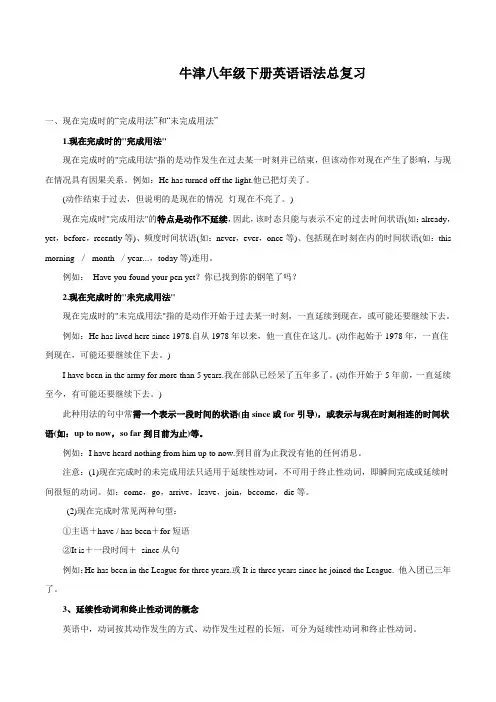

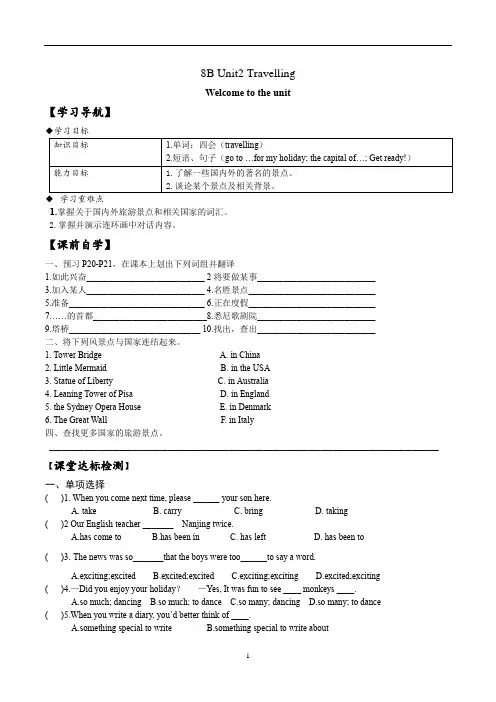
8B Unit2 TravellingWelcome to the unit【学习导航】◆学习目标1.掌握关于国内外旅游景点和相关国家的词汇。
2.掌握并演示连环画中对话内容。
【课前自学】一、预习P20-P21,在课本上划出下列词组并翻译1.如此兴奋___________________________ 2将要做某事___________________________3.加入某人___________________________4.名胜景点_____________________________5.准备_______________________________6.正在度假_____________________________7……的首都__________________________8.悉尼歌剧院___________________________9.塔桥______________________________ 10.找出,查出___________________________二、将下列风景点与国家连结起来。
1. Tower Bridge A. in China2. Little Mermaid B. in the USA3. Statue of Liberty C. in Australia4. Leaning Tower of Pisa D. in England5. the Sydney Opera House E. in Denmark6. The Great Wall F. in Italy四、查找更多国家的旅游景点。
_________________________________________________________________________________________【课堂达标检测】一、单项选择( )1. When you come next time, please ______ your son here.A. takeB. carryC. bringD. taking( )2 Our English teacher _______ Nanjing twice.A.has come toB.has been inC. has leftD. has been to( )3. The news was so_______that the boys were too______to say a word.A.exciting;excitedB.excited;excitedC.exciting;excitingD.excited;exciting( )4.—Did you enjoy your holiday?—Yes, It was fun to see ____ monkeys ____.A.so much; dancingB.so much; to danceC.so many; dancingD.so many; to dance( )5.When you write a diary, you’d better think of ____.A.something special to writeB.something special to write aboutC.special something to writeD.special something to write about( )6. -Is tea ready? -No,mother is ____ it ready now.A.doingB.cookingC.burningD.getting( )7.The Statue of Liberty is in _______.A. Pisa of ItalyB. London of EnglandC. Tokyo of JapanD. New York of the USA ( )8.Thailand is so hot that peoople like to go every day.A.skatingB.skiingC.cyclingD.swimming( )9.—When ______ you ______ in our city? —Last year.A. have; arrivedB. did; arriveC. will; arriveD. are; arriving.( )10.Which of the following is a symbol of Denmark?A. B. C. D.二、词汇运用1. Bob, if you are free, let me (带) you to the park.2.Where have you been on ______ (度假).3.We’re going to play football. Could you ______ (加入) us?4.Traveling in the forests must be ______.( 有趣)5.I hear my father will take me to the Summer Palace. I’m very ______.(兴奋)6.What’s ______ (特别) about the Great Wall?7.When Mr. Green saw these beautiful ______ (picture) , he was very happy.8.When they stayed in Beijing, they ______ (take) photos.9.What are you doing. I’m ______( get) all my things.10.The Whites often look at some pictures of some places of _______(interesting) around the world11.I saw a lot of children ______ (play) games on the playground when I passed there.12.How ______ you usually ______ (go) to work, Mr Green?plan success be interested in excite meaning laugh2.The boy studies hard. I think he will be ______in the future3.It is ______to plant trees in spring4.Since I was a child, I _______ singing. I wanted to be a singer..5.After hearing the funny joke, he couldn’t stop ______.四、完成句子(根据汉语完成句子,一空一词)1.我认为它对我来说不是一个假日。
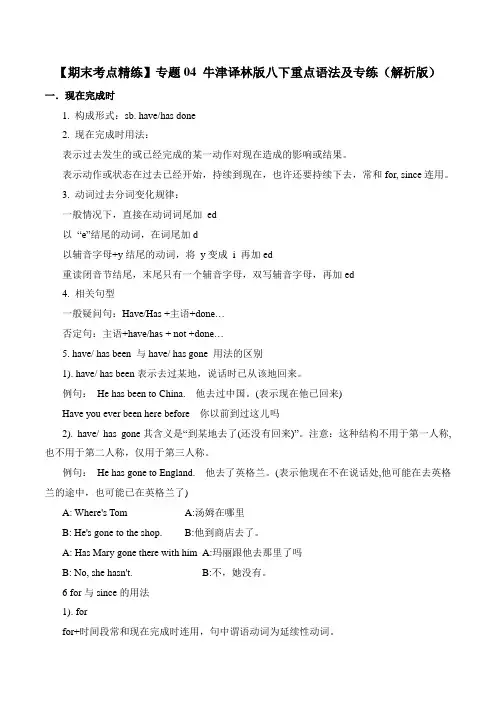
【期末考点精练】专题04 牛津译林版八下重点语法及专练(解析版)一.现在完成时1. 构成形式:sb. have/has done2. 现在完成时用法:表示过去发生的或已经完成的某一动作对现在造成的影响或结果。
表示动作或状态在过去已经开始,持续到现在,也许还要持续下去,常和for, since连用。
3. 动词过去分词变化规律:一般情况下,直接在动词词尾加ed以“e”结尾的动词,在词尾加d以辅音字母+y结尾的动词,将y变成i 再加ed重读闭音节结尾,末尾只有一个辅音字母,双写辅音字母,再加ed4. 相关句型一般疑问句:Have/Has +主语+done…否定句:主语+have/has + not +done…5. have/ has been 与have/ has gone 用法的区别1). have/ has been表示去过某地,说话时已从该地回来。
例句:He has been to China. 他去过中国。
(表示现在他已回来)Have you ever been here before 你以前到过这儿吗2). have/ has gone其含义是“到某地去了(还没有回来)”。
注意:这种结构不用于第一人称,也不用于第二人称,仅用于第三人称。
例句:He has gone to England. 他去了英格兰。
(表示他现在不在说话处,他可能在去英格兰的途中,也可能已在英格兰了)A: Where's Tom A:汤姆在哪里B: He's gone to the shop. B:他到商店去了。
A: Has Mary gone there with him A:玛丽跟他去那里了吗B: No, she hasn't. B:不,她没有。
6 for与since的用法1). forfor+时间段常和现在完成时连用,句中谓语动词为延续性动词。
例句:I have been a teacher for 10 years.我当教师已经有10年了。
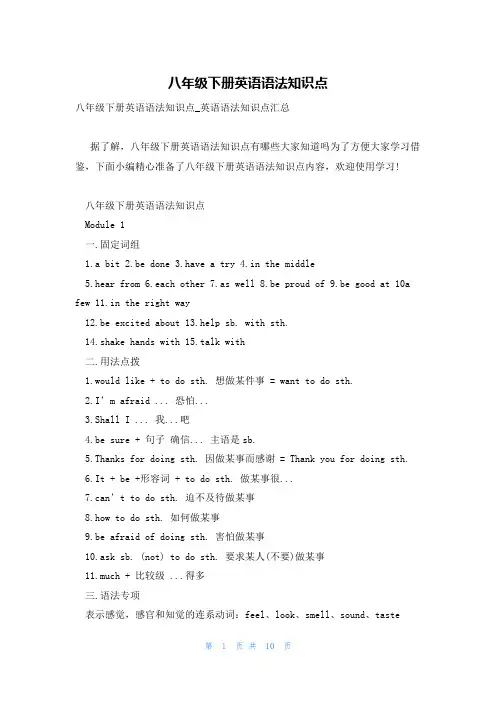
八年级下册英语语法知识点八年级下册英语语法知识点_英语语法知识点汇总据了解,八年级下册英语语法知识点有哪些大家知道吗为了方便大家学习借鉴,下面小编精心准备了八年级下册英语语法知识点内容,欢迎使用学习!八年级下册英语语法知识点Module 1一.固定词组1.a bit2.be done3.have a try4.in the middle5.hear from6.each other7.as well8.be proud of9.be good at 10a few 11.in the right way12.be excited about 13.help sb. with sth.14.shake hands with 15.talk with二.用法点拨1.would like + to do sth. 想做某件事 = want to do sth.2.I’m afraid ... 恐怕...3.Shall I ... 我...吧4.be sure + 句子确信... 主语是sb.5.Thanks for doing sth. 因做某事而感谢 = Thank you for doing sth.6.It + be +形容词 + to do sth. 做某事很...7.can’t to do sth. 迫不及待做某事8.how to do sth. 如何做某事9.be afraid of doing sth. 害怕做某事10.ask sb. (not) to do sth. 要求某人(不要)做某事11.much + 比较级 ...得多三.语法专项表示感觉,感官和知觉的连系动词:feel、look、smell、sound、taste__这些连系动词,后面通常接形容词Module 2一.固定词组1.lots of2.enter a competition3.first prize4.good luck5.think about6.a lot = very7.make up8.at the moment9.for example 10.be different from 11.so far 12.count down 13.by train 14.have a wonderful time 15.find out二.用法点拨1.help sb. + do sth. 帮助某人做某事2.stop doing sth.停止做某事3.need(实意动词) + to do sth.4.Invite sb. + to do sth. 邀请某人做某事5.one of + the +形容词最高级+复数名词表示“最...之一”6.love doing sth. 喜爱做某事7.have been to + sw. 去过某地(但已经回来) have gone to + sw. 去了某地(现在没回来)8.begin to do sth. 开始做某事9.enjoy doing sth. 喜欢做某事10.learn to do sth. 学习做某事三.语法专项现在完成时:构成have/has + 动词过去分词__不规则动词需额外记忆。
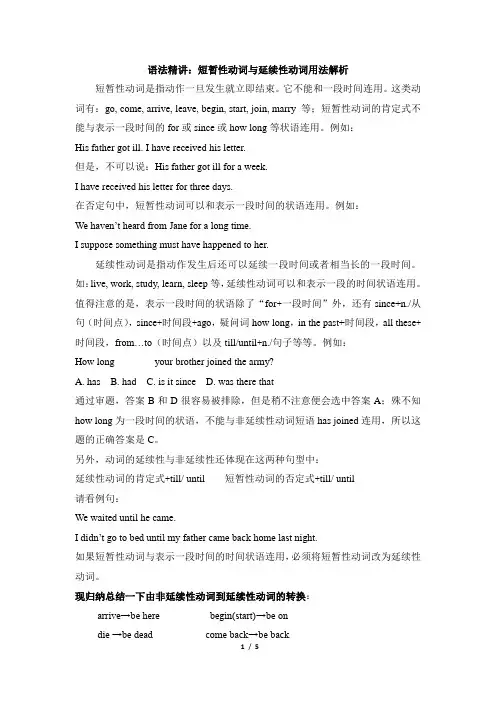
语法精讲:短暂性动词与延续性动词用法解析短暂性动词是指动作一旦发生就立即结束。
它不能和一段时间连用。
这类动词有:go, come, arrive, leave, begin, start, join, marry 等;短暂性动词的肯定式不能与表示一段时间的for或since或how long等状语连用。
例如:His father got ill. I have received his letter.但是,不可以说:His father got ill for a week.I have received his letter for three days.在否定句中,短暂性动词可以和表示一段时间的状语连用。
例如:We haven’t heard from Jane for a long time.I suppose something must have happened to her.延续性动词是指动作发生后还可以延续一段时间或者相当长的一段时间。
如:live, work, study, learn, sleep等,延续性动词可以和表示一段的时间状语连用。
值得注意的是,表示一段时间的状语除了“for+一段时间”外,还有since+n./从句(时间点),since+时间段+ago,疑问词how long,in the past+时间段,all these+时间段,from…to(时间点)以及till/until+n./句子等等。
例如:How long _______ your brother joined the army?A. hasB. hadC. is it sinceD. was there that通过审题,答案B和D很容易被排除,但是稍不注意便会选中答案A;殊不知how long为一段时间的状语,不能与非延续性动词短语has joined连用,所以这题的正确答案是C。
另外,动词的延续性与非延续性还体现在这两种句型中:延续性动词的肯定式+till/ until 短暂性动词的否定式+till/ until请看例句:We waited until he came.I didn’t go to bed until my father came back home last night.如果短暂性动词与表示一段时间的时间状语连用,必须将短暂性动词改为延续性动词。
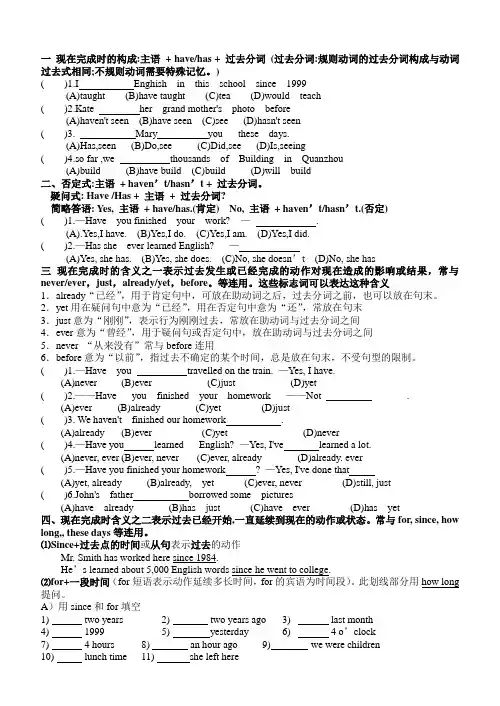
一现在完成时的构成:主语+ have/has + 过去分词(过去分词:规则动词的过去分词构成与动词过去式相同;不规则动词需要特殊记忆。
)( )1.I Enghish in this school since 1999(A)taught (B)have taught (C)tea (D)would teach( )2.Kate her grand mother's photo before(A)haven't seen (B)have seen (C)see (D)hasn't seen( )3. Mary you these days.(A)Has,seen (B)Do,see (C)Did,see (D)Is,seeing( )4.so far ,we thousands of Building in Quanzhou(A)build (B)have build (C)build (D)will build二、否定式:主语+ haven’t/hasn’t + 过去分词。
疑问式: Have /Has + 主语+ 过去分词?简略答语: Yes, 主语+ have/has.(肯定) No, 主语+ haven’t/hasn’t.(否定)( )1.—Have you finished your work? —.(A).Yes,I have. (B)Yes,I do. (C)Yes,I am. (D)Yes,I did.( )2.—Has she ever learned English? —(A)Yes, she has. (B)Yes, she does. (C)No, she doesn’t (D)No, she has三现在完成时的含义之一表示过去发生或已经完成的动作对现在造成的影响或结果,常与never/ever,just,already/yet,before。
等连用。
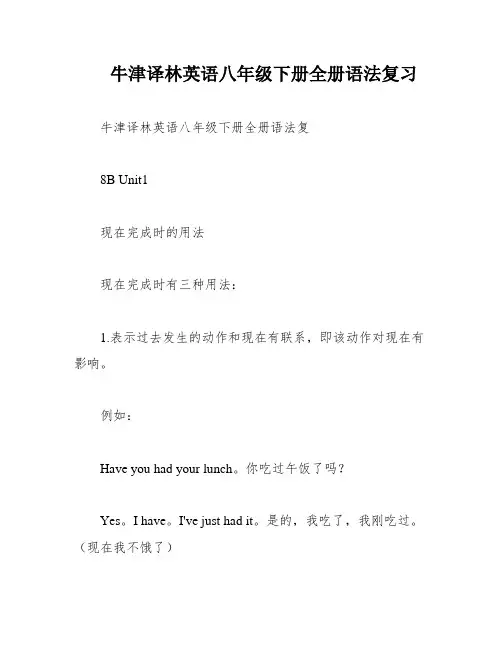
牛津译林英语八年级下册全册语法复习牛津译林英语八年级下册全册语法复8B Unit1现在完成时的用法现在完成时有三种用法:1.表示过去发生的动作和现在有联系,即该动作对现在有影响。
例如:Have you had your lunch。
你吃过午饭了吗?Yes。
I have。
I've just had it。
是的,我吃了,我刚吃过。
(现在我不饿了)I have already posted those photos。
我已经邮寄了那些照片。
(那些照片现在已不在我这里了)2.表示从过去某一时间开始一直持续到现在(包括“现在”在内)的动作,并且表示一段时间的状语连用,谓语动词多用延续性动词。
例如:I've known him for 3 years。
我认识他已经3年了。
They have lived here since 1996.自从1996年以来他们一直住在这里。
3.表示到现在为止多次发生的动作。
例如:XXX twice。
这部电影他已经看过两遍了。
My XXX has told me the story several times。
我爷爷已经把这个故事给我讲了好几遍。
现在完成时的构成现在完成时的构成为:肯定句:主语 + have/has + 动词的过去分词 + 其他。
否定句:主语 XXX 动词的过去分词 + 其他。
一般疑问句:Have/Has + 主语+ 动词的过去分词+ 其他?肯定回答:Yes,主语 + have/has。
否定回答:No,主语 + XXX't。
需要注意的是,主语是第三人称单数时用has,其他人称用have。
例如:XXX has heard from his XXX。
XXX这个月已收到了他爸爸的两次来信。
We have already cleaned our classroom。
我们已经打扫了教室。
现在完成时的标志词现在完成时的标志词包括:already,yet,ever,recently,just,before(用于句末),so far,for + 一段时间,since + 过去时间或一般过去时的句子。
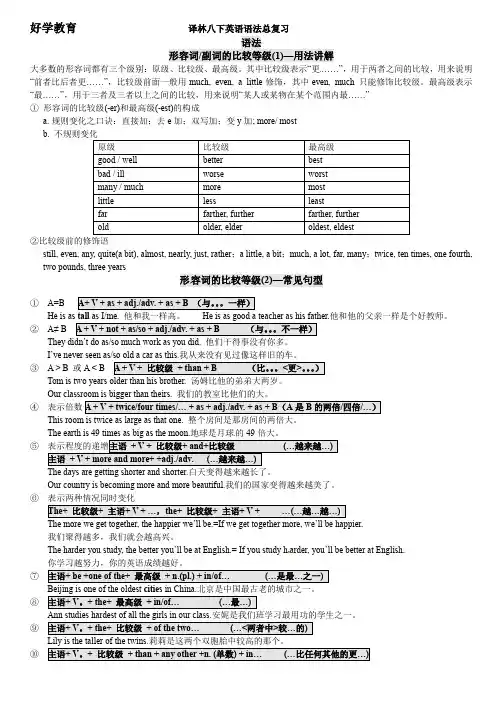
语法形容词/副词的比较等级(1)—用法讲解大多数的形容词都有三个级别:原级、比较级、最高级。
其中比较级表示“更……”,用于两者之间的比较,用来说明“前者比后者更……”,比较级前面一般用much, even, a little修饰,其中even, much 只能修饰比较级。
最高级表示“最……”,用于三者及三者以上之间的比较,用来说明“某人或某物在某个范围内最……”①形容词的比较级(-er)和最高级(-est)的构成a.规则变化之口诀:直接加;去e加;双写加;变y加; more/ mostb. 不规则变化原级比较级最高级good / well better bestbad / ill worse worstmany / much more mostlittle less leastfar farther, further farther, furtherold older, elder oldest, eldest②比较级前的修饰语still, even, any, quite(a bit), almost, nearly, just, rather;a little, a bit;much, a lot, far, many;twice, ten times, one fourth, two pounds, three years形容词的比较等级(2)—常见句型①A=B A+ V + as + adj./adv. + as + B (与。
一样)He is as tall as I/me. 他和我一样高。
He is as good a teacher as his father.他和他的父亲一样是个好教师。
②A≠ B A + V + not + as/so + adj./adv. + as + B (与。
不一样)They didn’t do as/so much work as you did. 他们干得事没有你多。
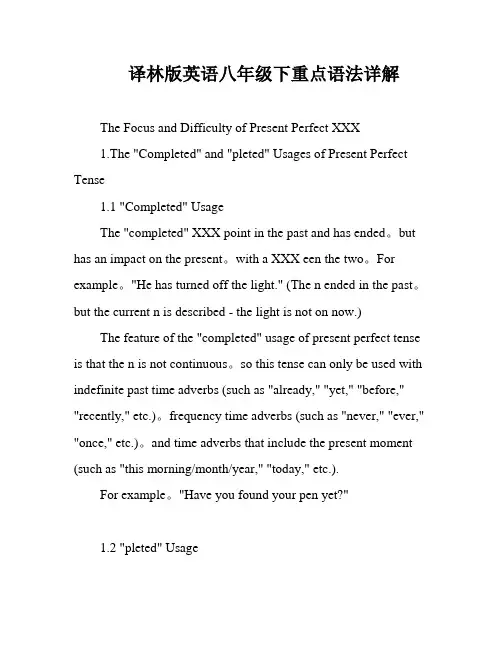
译林版英语八年级下重点语法详解The Focus and Difficulty of Present Perfect XXX1.The "Completed" and "pleted" Usages of Present Perfect Tense1.1 "Completed" UsageThe "completed" XXX point in the past and has ended。
but has an impact on the present。
with a XXX een the two。
For example。
"He has turned off the light." (The n ended in the past。
but the current n is described - the light is not on now.)The feature of the "completed" usage of present perfect tense is that the n is not continuous。
so this tense can only be used with indefinite past time adverbs (such as "already," "yet," "before," "recently," etc.)。
frequency time adverbs (such as "never," "ever," "once," etc.)。
and time adverbs that include the present moment (such as "this morning/month/year," "today," etc.).For example。
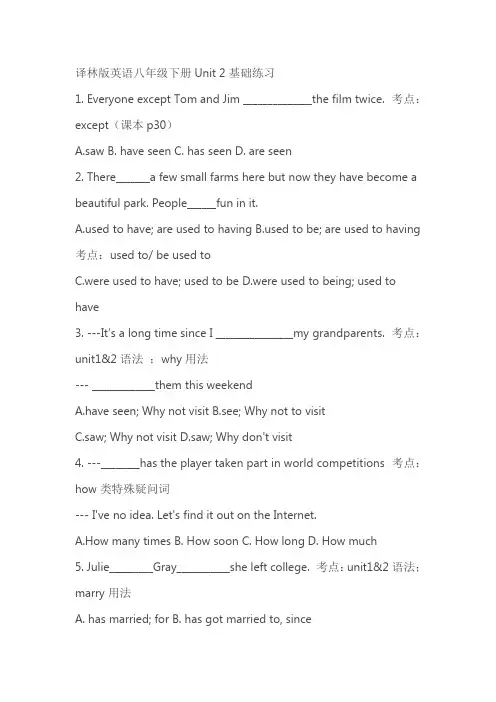
译林版英语八年级下册Unit 2基础练习1. Everyone except Tom and Jim ______________the film twice. 考点:except(课本p30)A.sawB. have seenC. has seenD. are seen2. There_______a few small farms here but now they have become a beautiful park. People______fun in it.ed to have; are used to havinged to be; are used to having 考点:used to/ be used toC.were used to have; used to beD.were used to being; used to have3. ---It’s a long time since I ________________my grandparents. 考点:unit1&2语法;why用法--- _____________them this weekendA.have seen; Why not visitB.see; Why not to visitC.saw; Why not visitD.saw; Why don't visit4. ---________has the player taken part in world competitions 考点:how类特殊疑问词--- I've no idea. Let's find it out on the Internet.A.How many timesB. How soonC. How longD. How much5. Julie_________Gray___________she left college. 考点:unit1&2语法;marry用法A. has married; forB. has got married to, sinceC. has been married with; sinceD. married; after6. ---He's seldom late for school,__________he 考点:反意疑问句---__________. He always gets to the classroom after the bell rings.A.is; NoB.is; YesC. has; YesD.has; No7. ---When________the travelers ___________the railway station 考点:arrive与reach的用法;When提问时态--- Half an hour ago.A. did; arriveB. have; been inC. did; reachD.have, come8. Why are you so late The parade_______________for a long time. 考点:unit2语法A. has begunB. has beenC.beganD.has been on9. Kitty and her parents went to Disneyland____________. 考点:表示时间的短语A.the next dayB.next dayC.tomorrowD.the other days10. ---Tomorrow is Sunday. How do you spend it---I want to go on ___ trip to___Great Wall. 考点:定冠词与不定冠词A. a; theB. /; theC. the; aD. the; /11. ---What's your hobby, Diana --Well, I have many hobbies, ____ dancing, singing and water sports.A. instead ofB. because ofC. such asD. for example 考点:unit2 p2212. .----I'd like to introduce my best friend to you, Peter. ---Thankyou, Lucy. But we____ already.A. meetB. have metC. will meetD. met 考点:unit1语法13. ---Did you enjoy the animal show 考点:unit2 p22---Yes. We just couldn't stop______ when the monkey began riding a bike.A. to laughB. laughingC. laughD. laughed14. _______ this term, I'm sure I'll get better grades because I study very hard. 考点:unit2 p23A. In the endB. At the endC. In the end ofD. At the end of15. John has _______ the Birdwatching Club for two months. 考点:unit2 语法A. joinedB. been a member ofC. take part inD. joined in16. _______great fun we had in the park! 考点:感叹句A. What aB. How aC. WhatD. How17. —Where have you _____ these days —I have______ to Hong Kong with my friends.A. been; goneB. been; beenC. gone; beenD. gone; gone 考点:unit2语法18. Zhang Liang was a cook years ago, but he ______ a model over the years. 考点:语法A. has becomeB. becameC. becomesD. has been19. Tom________Kate since two years ago, and they have had a child.考点:marry用法A. got married withB. married toC. has been married toD. married20. Mr Smith, together with his two sons, _______Shanghai for about five months. 考点:语法&插入语A. has leftB. have leftC. has been away fromD. have been away from21. --- How long _________ the play ______________---It______half an hour ago.A. has; been over; has finishedB. did; finished; finishedC. has; been over; finishedD. did; finish; finished22. --- Where is your dad---He __________ France. He won't come back __________ this weekend.A. has gone to; untilB. has been to; untilC. has been to; afterD. has gone to; after23. --- The changes are good for people.---______________. I like the present transport, but I can't stand the pollution.A. Yes, I agree with youB. No, you are wrongC. In some ways, I agree with youD. No, I agree with you答案:1-10 CBCADBCDAA 11-20 CBBDBABDCC 21-23 CAC【解析】1. Everyone except Tom and Jim ______________the film twice. 考点:except(课本p30)A.sawB. have seenC. has seenD. are seen【选C. 】except采用“就远原则”,主语是everyone,谓语动词用三单。
第 2 讲 第五单元-(语法、词汇、固定搭配各考点的复习)本次课课堂教学内容单项选择1. It’s said that many animals are in danger. So we need to _______them better.A. stopB.protectC. rememberD. search2. ---_______ can a tiger weigh, do you know?---Yes, I know that a big one can weigh over 200 kilos.A. How manyB. How heavyC. How muchD. What3. These animals are in danger. We should think to protect them.A.what can we doB. what we can doC. how can we doD. how we can do4. ---I think English is ________ unimportant subject.---I don’t think so. It is ________ useful tool when we talk with foreigners.A. a; anB. an; aC. a; aD.an; an5. ---_______ David be the new chairperson of the Reading Club?---He ________ be, but I’m not certain about it.A.Can; can’tB. May; mustn’tC.May; mustD. Can; may6. Is the door of the classroom______or _______?A. open; closeB. open; closedC. opened; closedD. opened; close7. ---Lily, hand in your homework, please.---Oh, sorry. I _______it home this morning.A.forgotB.leftC. will leaveD.was forgetting8.The old man lived in that place .A.lonely ; lonelyB. alone; aloneC. alone ; lonelyD.lonely; alone9.If we don't do anything to protect tigers, the number of the tigers in the wild willbecome .A.fewer and fewestB.fewer and fewerC.smaller and smallerD.smaller and smallest10.If we______, soon there may be______ left in the world. So we need to take action to protect giantpandas.A. do nothing; noneB. don’t anything; noneC. don’t do anything; nothingD. don’t take action; nothing11.Like other wild animals, wolves only hunt_____food. And they hunt_____ a team.A. for; withB. as; forC. for; likeD. for; as12.There were so many interesting animals in the zoo.I couldn’t decide________first.A.to watch whichB.which to watch oneC.which one to watchD.to watch which one13. My parents often tell me too much time computer games.A. not to spend; playingB. not to spend; to playC. to not spend; playD. to not spend; playing14. ---How nice the building is ! What is it for?---It a hotel. But I'm not sure.A. must beB. have to beC. may beD. can be15. —What's the weight of your daughter when she was birth ?—She about 3.3 kg.A. in; weightB. at; weightC. at; weighedD. in; weighs16. I can't follow you. Could you speak a little ?A. slowB. more slowlyC. slowlierD. most slowly17.---Which is your favourite drink,juice,water or milk?---Thanks,but I’m sorry I like_________of them.I like coffee most.A.nothingB.no oneC.noneD.not all18. How_________ we are at the _________ news!A. excited; excitedB. exciting; excitingC. excited; excitingD. exciting; excited19. She likes to sleep with the windows _________.A. openedB. openingC. openD. opens20. If________a meeting this afternoon, we won’t go to the zoo.A.there will beB.there hasC.there isD.there will have词汇运用1.All the__________(hunt)in that small village used to lived on hunting.2.We must do something to p__________ wild animals.3. Many people lost their l__________ in the traffic accident.4.Many animals__________(live)areas are becoming farmland.5. W are large wild animals of the dog family, live and hunt in groups.6. When did Xi Wang start to look after (she)?7. At the very (begin), she didn’t know this city.8. The little boy is crying. He may be___________ (害怕) of them.9. You may get _________ (丢失) in the forest on foggy days.10. Remember ___________ (关) off the lights when you leave the classroom.11. They all agreed _____________(do) something for the wild animals.12. The boy kept ___________ (ask) his teacher the same question.13. You need __________ (wear) warmer clothes because it’s colder.14. H____________ often kill wild animals for their fur.15. We are happy that ______________ (没有一个) of us failed the exam.16. Jim was happy to ____________ (接受) the job.17. The teacher is making a _______ (报告) on animals in the hall.18. He ________(接受)this job and worked very hard to make money.19. I saw a little girl ________(卖)flowers at the bus stop when I got off the bus.20. When baby pandas are born, they look like white___________(mouse).21. He is in ____________ (危险) now, let’s go and help him.22. The students of Class 6 are writing an___________(invite)letter to Mr.Li.23. Good friends should share_____________(happy)with each other.24.Nirvana in Fire(琅琊榜)is the_________(begin)of Wang Kai’s successful career.25. What's the ________ (意思)of this word?26.Giant pandas live (主要地) on bamboo shoots and leaves.27.They think wolves are dangerous to (人类)28. The __________(hunt) always hunt tigers for their fur and bones.29. I think it is quite ____________(danger) to keep a big snake as a pet.30. ____________(mouse) are afraid of cats.31. He died in a hospital yesterday after a short (ill).32. Walking ________(慢慢地)is good for our health.33.Losing___________(weigh)takes a lot of time and effort.You shouldn’t give up.34.His____________(ill)stopped him from going to school as other students did.ually____________(狼)catch small animals for their food.36._____________(保护区)are good places for wild animals to live.37.Wait a minute.My brother will be back in short____________(一会儿).38. We should finish our___________(report)about wild animals before next Friday.39.Mr Wu received many presents on Teachers’ Day , but he_________(接受)none.40.We hope you can accept our (邀请) and join us.41. Horses can stand to sleep with eyes ___________(close).42.He is so kind that he often takes___________(同情)on the poor people.43.The man_______________(卖)a tiger’s fur to make a lot of money.44.A few traffic accidents happened yesterday because of the_______(浓)fog(雾).语篇类阅读练习秘密花园(一)The Secret Garden is a novel by Frances Hodgson Burnett , first published in 1909.Mary Lennox, the main character of The Secret Garden, started out in India with her parents. She was in a village, where a serious disease killed everyone e 1 her. As a result, the little girl, l 2 and sad, was sent to live with her uncle, Archibald Craven in a place called Misselthwaite Manon, England. There were over 100 rooms in the house.After she a 3 , Mary was taken care of by Martha Sowerby, her servant and maid. One day, by accident, Mary heard Martha talk about a secret garden. But Archibald locked the garden and h 4 the key because the garden reminded him of his dead wife.N 5 would tell her whom it came from. And she was not a 6 to find out, so she decided to secretly find out for h 7 . The discovery of the garden parallels Mary’s discovery of her cousin,Colin Archibald, who was weak and always in bed.He couldn’t move and was raised in his own room with servants. Everyone thought he was going to die. His face was so s 8 to Archibald’s wife that Archibald didn’t want to see it in order not to feel sad. Mary found out the secret but dead garden and tried to bring it back to l 9 with Dickon. Mary met with him veryoften, but he got mad when she went to the garden instead of talking with him. With the help of Mary and Dickon, Colin, in his wheelchair,entered the secret garden where he learned to w 10 .(二)Finally Mary, Dickon, Colin, and Ben Weatherstaff, the gardener, took care of it and raised it back into a lively, beautiful garden again.Every day at Misselthwaite Manor was e 1 the same as the day before. Mary woke up in her room and Martha was l 2 her fire. Then she ate her breakfast and after that she went out and ran around the gardens. She h 3 the strong wind. But the f 4 air put colour into her cheeks and soon she started eating more.There were no toys in her room or in the garden. So, because she had n 5 to play with, she walked a lot and looked at things. Sometimes she saw Ben Weatherstaff, but was always busy and he usually looked c 6 .Her f 7 walk was the long path outside the walked gardens. The walls around the gardens were c 8 in thick ivy but there was one part where the ivy was much t 9 .One day Mary saw Ben Weatherstaff's robin on top of the wall. She was very happy to see him again.The bird chirped and whistled. Did he know her? Was he speaking to her?'It's me, Mary!' she shouted. 'I like you! I like you!'He f 10 to the top of a tree and started singing loudly.'He's in the secret garden,' Mary thought.She walked to one end of the ivy-covered wall and then she walked to the other end. She looked very carefully but she couldn't see a door.红发会(一)The first thing that disturbed us was that advertisement. Spaulding came into the office 8 weeks ago, with this paper in his hand, and he said: “I wish ,Mr.Wilson,that I was a red-headed man.”“Why?” I said.“Because,” he said, “there’s another vacancy(空缺) at the League of Red-Headed Men. It’s worth a fortune to the man who gets it, and I understand that there are more vacancies than there are men.”“Why,what is this ‘League?’ I asked.You see, Mr. Holmes, I am a very stay-at-home. My business comes to me and I am often weeks on end without putting my foot over the door-mat. So I don’t know what is going on outside, and I am always happy to hear some news.”“Have you never heard of the League of Red-headed Men?” he asked with his eyes open.“Never.”“Why,that is strange,for you are eligible for one of the vacancies.”“And what are they?” I asked.“Oh,each vacancy pays a couple of hundred pounds a year.But there is little work to do.”“Well, you can be sure that I was interested. My business was not very successful, and I liked the thought of an extra couple of hundred pounds.”“Tell me all about it.” I said.“Well,” he said,showing me the advertisement, “you can see yourself that the League has a vacancy. Here is the address where you can apply for details. The League was founded by an American millionaire, Ezekiah Hopkins, who was very strange in his ways. He was red-headed, and he had a great sympathy for all red-headed men. So, when he died,he left his money to a group of trustees, with instructions to give the money to men with red hair. It is good pay and there is very little to do.”“But,” I said,”there are millions of red-headed men who can apply.”“Not as many as you think,” he answered. “You see it only for Londoners,and grown men. This American came from London, and he wanted to do something good for the old town. And ,I have heard,you can’t apply if your hair is light red, or dark red,or anything but real bright,blazing,fiery red. Your hair is perfect, Mr.Wilson, if you want to apply. But perhaps it’s not worth your while applying for just a couple of hundred pounds. ”---Taken from the Red-Headed League 1. According to this passage, why does Ezekiah Hopkins start the Red-Headed League? Because ______.A. he had little work to do every day.B. he had too much money ,and didn’t know what to do with it.C.the harder he worked, the greater progress he made.D.he had great sympathy for all red-headed men.2. You don’t need__________________ before you join the league ?A. to be an adultB. to be from LondonC. to have enough moneyD.to have bright red hair3. Which of the following sentences is right ?A.A millionaire from Australia founded the Red-Headed League.B.The vacancy pays hundreds of pounds and there’s a lot of work to do.C.Ezekiah Hopkins left his money to anyone who could join the league..D.Spaulding knew what happened outside though he stayed at home all day long.4. The last paragraph(段落) mainly tells us__________________.A.anyone who apply for the vacancy can get several hundred poundsB.who can become a member of the Red-Headed LeagueC.someone with red hair can apply for the vacancyD.what the people (who apply for the vacancy) should do before applying(二)"Now, it is a fact, gentlemen, as you may see for yourselves that my-hair is a full and rich red. So I decided to apply for the vacancy (空缺职位)."Well, Mr. Holmes, every man who had red hair was there to answer the advertisement. But, as Spaulding said, there were not many with the real vivid flame-coloured red. When I saw all these men, I wanted to go away, but Spaulding refused. He pushed and pulled until we moved through the crowd, and right up to the office.""There was nothing in the office but a couple of wooden chairs and a table, A small man with a head that was redder than mine wasting behind the table. He said a few words to each candidate and then he sent them away. Getting a place in the League did not seem to be very easy. However, when it was our turn the little man closed the door so he could have a private word with us.'This is Mr. Jabez Wilson,' my assistant said, 'and he wants to apply(申请)a place in the League.’'And he is perfect for it,' the other answered. 'I cannot remember the last time I saw hair so perfect.' He took a step backwards and looked at my hair until I felt embarrassed. Then suddenly he moved forward, shook my hand, and congratulated me on my success.'The vacancy is yours,' he said. 'Excuse me for taking an obvious precaution.' And with that he took my hair in both his hands, and pulled until I shouted with the pain. 'There is water in your eyes. Now I know that your hair is real. We have to be careful." He stepped over to the window and shouted through it at the top of his voice that the vacancy was full. We heard a groan of disappointment and the men went away in different directions until there was not one red-head left, except me and the manager...-----Taken from The Red-Headed League1. Why did the manager pull Mr. Jabez Wilson's hair?A. Because he wanted to make Mr. Jabez Wilson believe him.B. Because he liked Mr. Jabez Wilson's red hair.C. Because he wanted to make friends with Mr. Jabez Wilson.D. Because he thought Mr. Jabez Wilson's red hair was the best.2. The underlined word “ he ” in Paragraph 6 refers to(指) ?A. Mr. HolmesB. SpauldingC. Mr. Jabez WilsonD. The little man3. Which of the following is NOT true according to the passage?A. Mr. Jabez Wilson applied for the vacancy in the league finally.B. Getting a place in the League did not seem to be very easy.C. People who had red hair were there to answer the advertisement.D. Only Spaulding thought Wilson was the right person for the vacancy.4. What does the underlined word “refused” mean in Paragraph 2?A. 索要B. 拒绝C. 赞同D. 感谢本次课课后练习黑骏马(一)The first day we travelled not long, but James drove c1 and made sure that Ginger and I were always on the smoothest road. It was evening when we a2 at the hotel. It was in the Market Place and two stablemen(马夫) came o3 to us.The chief stableman was old, and he led me into a stable(马厩). There were two or three h 4 in it. The younger man brought in Ginger, and James watched there.“I thought I was quick,” James told the old stableman, “but you're q5 than anyone.”“I started to w6 with horses when I was 12,and it's good to be a7 to work with a well-cared animal like this. Who is your m8 ?”said the stableman.“Mr. Gordon of Birtwick Park.” said James.“Oh, he’s the best rider in the country. He knows horses m9 than any other people.” said the stableman.“He doesn't ride very often now since the poor young master d10 (He was killed in an accident).”said James.(二)At three o'clock in the afternoon Mr York took us round to the front of the house. It was very grand. Soon the lady of the house came and looked at us. She said nothing, and got into the carriage. This was the first time I wore a short rein. And it was very u_____________1__.The next day the lady said, “York, you must put those h___________2__ heads higher.”That day we had to go up a huge hill. I tried to pull the carriage along, but I had to pull with my head up. It was hard and it h__________3__my back and legs.After that our reins got shorter and shorter every day. I hated it. And things got w__________4__ after that.One day Mr York fixed the rein very tight. It was t__________5__.Ginger didn't like it at all. She reared(用后腿直立起来)up. York hit his nose and his hat fell off. She reared a__________6__, and kicked. Then she fell down, k_________7__ me too. I stood, angry, with a sore(疼痛的)leg, my head still high. I was miserable(痛苦的).。
【期末考点精练】专题04 牛津译林版八下重点语法及专练(解析版)一.现在完成时1. 构成形式:sb. have/has done2. 现在完成时用法:表示过去发生的或已经完成的某一动作对现在造成的影响或结果。
表示动作或状态在过去已经开始,持续到现在,也许还要持续下去,常和for, since连用。
3. 动词过去分词变化规律:一般情况下,直接在动词词尾加ed以“e”结尾的动词,在词尾加d以辅音字母+y结尾的动词,将y变成i 再加ed重读闭音节结尾,末尾只有一个辅音字母,双写辅音字母,再加ed4. 相关句型一般疑问句:Have/Has +主语+done…?否定句:主语+have/has + not +done…5. have/ has been 与have/ has gone 用法的区别1). have/ has been表示去过某地,说话时已从该地回来。
例句:He has been to China. 他去过中国。
(表示现在他已回来)Have you ever been here before? 你以前到过这儿吗?2). have/ has gone其含义是“到某地去了(还没有回来)”。
注意:这种结构不用于第一人称,也不用于第二人称,仅用于第三人称。
例句:He has gone to England. 他去了英格兰。
(表示他现在不在说话处,他可能在去英格兰的途中,也可能已在英格兰了)A: Where's Tom? A:汤姆在哪里?B: He's gone to the shop. B:他到商店去了。
A: Has Mary gone there with him? A:玛丽跟他去那里了吗?B: No, she hasn't. B:不,她没有。
6 for与since的用法1). forfor+时间段常和现在完成时连用,句中谓语动词为延续性动词。
例句:I have been a teacher for 10 years.我当教师已经有10年了。
8下语法知识总结Unit 1 Past and Present1、现在完成时的肯定句、否定句的构成(以实义动词work为例)肯定句:I/We/You/They have (I/We/You/They’ve) worked.否定句:I/We/You/They have not (I/We/You/They haven’t) worked.肯定句:He/She/ It has(He’s/She’s/It’s) worked.否定句:He/She/It has not(hasn’t) worked.2、现在完成时的一般疑问句及其简略答语(肯定、否定)的构成一般疑问句:Have I/we/you/they worked?肯定简略答语:Yes, I/we/you/they have.否定简略答语:No, I/we/you/they have not(haven’t).一般疑问句:Has he/she/ it worked?肯定简略答语:Yes, he/ she/it has.否定简略答语:No, he/she/it has not (hasn’t).3、现在完成时的用法用法1:过去开始发生的动作或存在的状况一直延续到现在例句:They have waited for more than two hours.他们等了两个多小时。
He has been an English teacher since 2002.自从2002年以来他一直当英语教师。
特别提示:常用的标志词有:for t wo days/ weeks…, for a long time, since last year/ 2005…用法2:表示过去已经完成的动作对现在造成的影响例句:I’ve alread y mailed the letter.那封信我已经寄出。
Have you ever eaten French cheese? 你(曾经)吃过法国奶酪吗?Has it stopped raining yet? 雨已经停了吗?(yet表示期待雨停止)I have just finished my homework. 我刚做完家庭作业。
译林版八年级下英语各单元必考知识点汇编【聚焦中考】:Unit1 必考知识点汇编考点一:非谓语动词1.You used to be so kind to me.你过去对我很友好。
(教材第6页)中考链接1、(2014·南充中考)She used to _____ a bus to school, but now she is used to _____to school. A, taking,walkB. take,walkC. taking,walkingD. take,walking考点二:连词before的用法2. It has become impossible for us to see each other as often as before. 我们不太可能像以往一样频繁的见面了。
(教材第9页) 中考链接2、(2014 济宁中考)Laura opened the door and rushed into the rain_____ I couldstop her.A. untilB. afterC. beforeD. unless3、(2015襄阳中考)—Did you catch the first subway this morning?—No, I didn’t. It had started moving __________ I could get on it.A. beforeB. sinceC. afterD. as soon as考点三:动词词义辨析3. There were always too many people on the bus, and it took a long time to wait for the next one.公交车上总是有太多人,等下一班要花很长时间。
(教材第7页) 中考链接4、(2014 临沂中考)It _____ about eight minutes for sunlight to travel from the sun to the earth.A. takesB. spendsC. costsD. pays5、(2015襄阳中考)—It’s reported that Chinese ___________more than 40 minutes a day reading WeChat(微信).—It’s true. But I think WeChat is taking too much of our time.A. spendB. costC. payD. take考点四:动词短语辨析4. Now the government has turned part of the town center into a new park.政府已经把镇中心的部分地方变成了一个新公园。